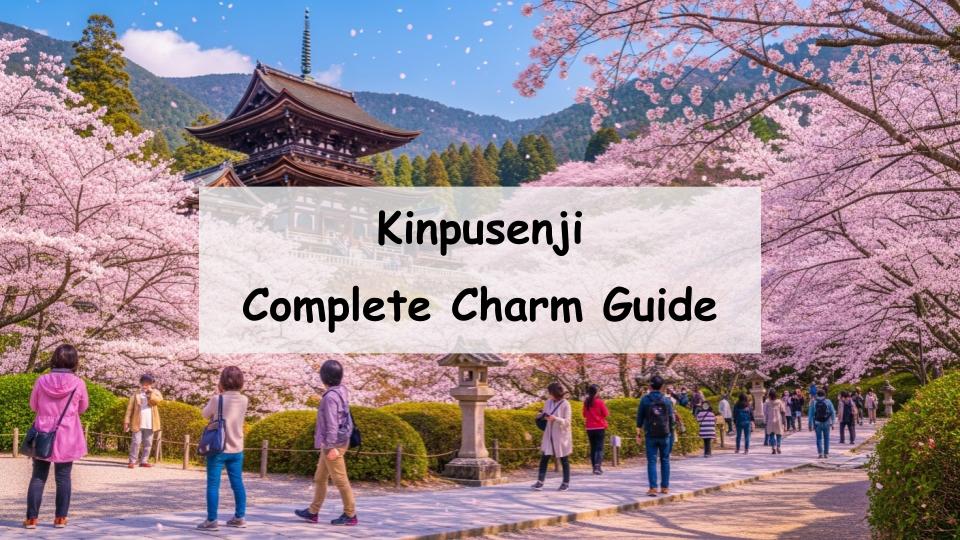“What’s Kinpusen-ji Temple like? Is it really famous for cherry blossoms?” If you’ve ever wondered this, you’re not alone.
Located in the heart of Yoshino Mountain in Nara, Kinpusen-ji (pronounced Kinpusenji) is a sacred temple known as the spiritual home of Shugendo, a Japanese mountain ascetic tradition. Recognized as a UNESCO World Heritage Site, this historic temple attracts countless visitors every spring when the entire mountain transforms into a sea of cherry blossoms, famously known as “Ichimoku Senbon” (a thousand trees at a glance).
In this article, we will explore everything about Kinpusen-ji Temple — from its deep-rooted history and religious significance to seasonal highlights, temple etiquette, and detailed travel information. Let this guide be your companion in planning a memorable visit to one of Japan’s most spiritually and visually captivating temples.
What Is Kinpusen-ji Temple? History and Cultural Background
The Role of a Sacred Site in Shugendo
Kinpusen-ji is the headquarters of Shugendo, a syncretic religion combining mountain worship, Buddhism, and Shinto. Practitioners, known as yamabushi, train in the rugged terrain of Yoshino, and the temple plays a central role in their spiritual discipline.
Why It Became a UNESCO World Heritage Site
Designated in 2004 as part of the “Sacred Sites and Pilgrimage Routes in the Kii Mountain Range,” Kinpusen-ji is recognized for its historical importance and harmonious relationship with nature and religious practice.
The Origins and Legends Behind Kinpusen-ji
Founded in the 7th century by En no Gyōja, the legendary founder of Shugendo, Kinpusen-ji has been a sanctuary for spiritual seekers for over 1,300 years. Its origin is steeped in myths and legends passed down through generations.
Highlights of Kinpusen-ji Temple
Zao-do Hall: The Majestic Main Building
Standing 34 meters tall, the Zao-do Hall is Japan’s second-largest wooden structure. Its sheer scale and architectural beauty are awe-inspiring, and it houses the temple’s principal deity.
The Secret Statue of Zao Gongen
Zao Gongen, the fierce guardian deity of Shugendo, is usually hidden from view. However, during special openings (kaichō), visitors can witness this rarely seen, spiritually powerful figure.
Scenic Views from the Temple Grounds
The temple grounds offer panoramic views of the Yoshino mountains, which are especially breathtaking during spring and autumn, when nature paints the landscape in vibrant hues.
Seasonal Beauty, Especially the Cherry Blossoms
Each spring, the slopes of Yoshino Mountain erupt into a blanket of pink cherry blossoms, drawing travelers from all over Japan and beyond. The view from Kinpusen-ji is among the most iconic in the region.
Annual Events and Festivities
Shugendo Ceremonies and Ascetic Experiences
Visitors can witness or even take part in rituals rooted in Shugendo, offering a unique spiritual and cultural experience.
Spring Flower Festivals and Seasonal Events
The cherry blossom season is marked by temple festivals and ceremonies that celebrate both nature and faith.
Autumn Light-Up Events
In fall, the temple and surrounding maple trees are illuminated at night, creating a magical and serene atmosphere for evening visitors.
How to Get to Kinpusen-ji Temple
By Train and Bus
Take the Kintetsu Line to Yoshino Station. From there, a ropeway and a short walk will bring you to the temple area.
By Car and Parking Information
Parking is available near the temple area, but traffic and congestion during peak seasons can be intense, so early arrival is recommended.
Hours, Admission Fees, and Time Required
The temple is typically open from 8:30 AM to 4:30 PM. Admission varies based on special exhibitions. Allow 1–2 hours for a thorough visit.
Nearby Attractions in Yoshino
Combine Your Visit with Yoshino’s Famous Cherry Blossom Trails
Kinpusen-ji is just one part of the greater Yoshino area, which features tiered cherry blossom zones — perfect for walking and photography.
Hot Springs and Local Cuisine
Relax in a nearby onsen (hot spring) and enjoy Yoshino’s specialties such as kakinoha sushi and handmade soba noodles.
Temple Lodging and Traditional Ryokan Stays
For an immersive experience, stay overnight in a local shukubo (temple lodging) or a traditional inn.
What to Know Before Visiting Kinpusen-ji
Appropriate Attire and Temple Etiquette
Dress modestly and be respectful when entering sacred areas. Photography may be restricted in some locations.
Tips for Avoiding Crowds
To avoid large tour groups, visit on weekday mornings, especially during cherry blossom season.
Best Times to Visit by Season
Spring (late March to early April) is cherry blossom time, while autumn (late October to early November) offers spectacular fall foliage.
Conclusion: Reconnect with Nature, Faith, and History
A Deeply Enriching Experience in Nature and Spirituality
Kinpusen-ji offers more than just visual beauty—it’s a place to reconnect with history, culture, and inner peace.
Add Kinpusen-ji to Your Travel Itinerary
Whether you’re seeking seasonal beauty or spiritual depth, Kinpusen-ji is a must-visit destination in Japan.





Comment